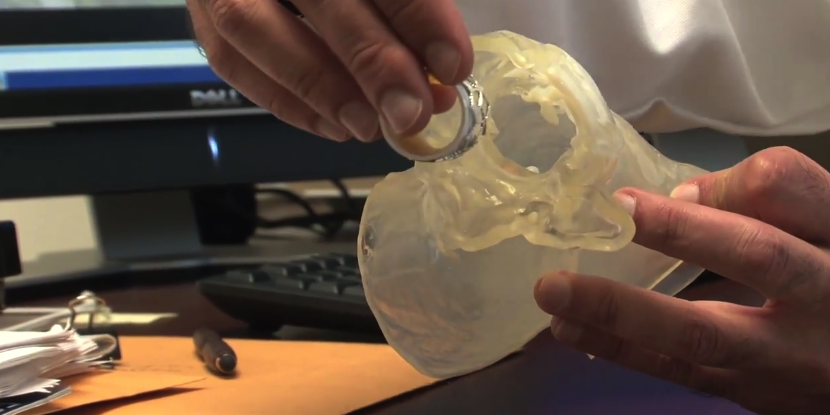When it comes to complicated surgeries, 3D printing has really begun to make inroads in areas that previous technologies have had a difficult time with. We’ve seen the technology used to create medical models which have aided surgeons in procedures previously thought to be inoperable. These 3D printed models are capable of providing doctors with a tangible replica of arteries, organs and other tissues within the human body that previously were only replicable via 2-dimensional CT scans, MRIs and X-rays.
 Recently at UCLA, doctors were able to use a 3D printed heart model to go forth with a very complicated surgery on 66-year-old Richard Whitaker. Whitaker had been suffering from congestive heart failure, which resulted in two hospital stays over a period of months, and needed something done in order to save his life. He had been suffering from swollen ankles and extreme fatigue, as his lungs were not getting proper blood flow. He had very rare and unusually large pulmonary arteries, and this caused doctors quite a bit of concern as they contemplated different possible routes to take on replacing Whitaker’s defective pulmonary valve. Because of this, they elected to 3D print a model of his heart, including multiple materials in order to best replicate the organ. To do this, they utilized the services of Materialise.
Recently at UCLA, doctors were able to use a 3D printed heart model to go forth with a very complicated surgery on 66-year-old Richard Whitaker. Whitaker had been suffering from congestive heart failure, which resulted in two hospital stays over a period of months, and needed something done in order to save his life. He had been suffering from swollen ankles and extreme fatigue, as his lungs were not getting proper blood flow. He had very rare and unusually large pulmonary arteries, and this caused doctors quite a bit of concern as they contemplated different possible routes to take on replacing Whitaker’s defective pulmonary valve. Because of this, they elected to 3D print a model of his heart, including multiple materials in order to best replicate the organ. To do this, they utilized the services of Materialise.
“We are harnessing the latest technologies such as 3D printing to help us better address the most complicated cases,” said Dr. Jamil Aboulhosn, director of the Ahmanson/UCLA Adult Congenital Heart Disease Center and the Streisand/American Heart Association Endowed Chair in the Division of Cardiology at the David Geffen School of Medicine at UCLA.
The 3D printed heart model was created by taking a CT scan of Whitaker’s chest. The majority of the model consisted of a silicone-like material which was aimed at replicating the properties found within his heart tissue, while a harder material was used in order to replicate rigid calcium deposits within the organ. Working with Dr. Daniel Levi and Dr. Morris Salem, Dr. Aboulhosn was able to perform a mock surgery on this 3D printed heart, allowing the team to ensure that the replacement valve that would ultimately be inserted into Whitaker’s artery could fit his extra-large pulmonary arteries.
Once the surgical team felt confident in performing the mock surgery, it was on to the real thing. They fed a valve and stent through a vein in Whitaker’s groin, all the way up to his heart, using a catheter. Once the valve was put into the correct location, it began working instantly, controlling the blood flow between his heart and lungs, allowing for it to only flow in one direction.
“We are very pleased that Richard is doing well,” said Dr. Aboulhosn, who also is an associate professor of cardiology and pediatrics. “With technologies such as 3-D printing and advances in minimally invasive procedures, congenital heart patients who might not have survived childhood 40 years ago are able to lead full, normal lives today.”
Within four days, Whitaker was discharged from the hospital, ready to resume a normal life and travel with his family, something which was greatly inhibited previously.
“I didn’t miss a beat and was able to get back to my life quickly,” Whitaker stated.
This is just one more case in which 3D printing was able to save the day. Without the advent of this technology, the surgery would have been much more tricky. The technology certainly will continue to gain traction within the medical field.
“The models created from 3-D printing are becoming more and more realistic,” Dr. Levi explained. “Even now, they allow us to predict which strategies we can use and in which patients. In the future, they will be used to not only simulate procedures but also allow more rapid development of new devices to help individual patients.”
What do you think about this latest case of 3D printing coming to the rescue of a patient? Discuss in the 3D printed heart model forum thread on 3DPB.com. Check out the video of this story below.
Subscribe to Our Email Newsletter
Stay up-to-date on all the latest news from the 3D printing industry and receive information and offers from third party vendors.
You May Also Like
UltiMaker Takes on Industrial Market with Factor 4 3D Printer
UltiMaker has announced its newest industrial 3D printer: The Factor 4. Unveiled officially at the HANNOVER MESSE trade show today, the Factor 4 is being positioned as a new flagship...
3D Printing Webinar and Event Roundup: April 21, 2024
It’s another busy week of webinars and events, starting with Hannover Messe in Germany and continuing with Metalcasting Congress, Chinaplas, TechBlick’s Innovation Festival, and more. Stratasys continues its advanced training...
Nylon 3D Printed Parts Made More Functional with Coatings & Colors
Parts 3D printed from polyamide (PA, Nylon) 12 using powder bed fusion (PBF) are a mainstay in the additive manufacturing (AM) industry. While post-finishing processes have improved the porosity of...
3D Printing Webinar and Event Roundup: April 14, 2024
We’re starting off the week’s 3D printing webinars and events at ASTM AMCOE’s 11th Snapshot Workshop and MACH Exhibition. Stratasys continues its advanced training courses, SME is holding a virtual...


































